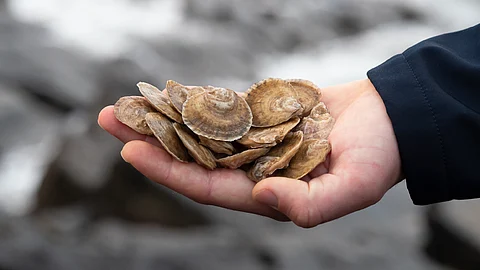

Native oysters in hand.
Photo: RWE / The Oyster Restoration Company.
Leading offshore wind company RWE and The Oyster Restoration Company (TORC) have taken an important step forward for offshore wind developers by completing a feasibility project that proves large-scale native oyster reef restoration can be executed at offshore wind farms in the North Sea.
According to the joint release from RWE and TORC, the learnings from this project are expected to support offshore wind's ambitions to contribute to the restoration of important marine habitats in large areas of the North Sea, the UK, and Europe.
Based in Aultbea, in Mellon Charles, North-West Scotland, The Oyster Restoration Company is an aquaculture firm dedicated to restoring and protecting native oyster habitats across the UK and the rest of Europe's coastal waters to support marine biodiversity, enhance ecosystem health, and combat climate change. In recent months, it has made significant moves such as joining an industry alliance to tackle European oyster disease, or the launch of a new solution for faster recovery of oyster reefs.
As the global sea urchin ranching and kelp restoration company Urchinomics, TORC is also part of Cadman Capital Group, a private, independent venture capital investment firm pioneering environmental and social governance investment whose aquaculture portfolio focuses on developing leading-edge technology and innovative hatchery practices to support the sustainability of global fish stocks.
On its website, The Oyster Restoration Company highlights that 95% of Europe's native oyster reefs have disappeared. Therefore, its work focuses on rejuvenating and preserving coastal ecosystems by leading innovative and sustainable oyster restoration initiatives because, as the joint RWE and TORC release recalls, flat oysters are an important species as they can create reefs that provide food and breeding grounds for many other species.
Due to the harmful impacts of factors such as overfishing, pollution, and parasites, only 5% of the pre-industrial flat oyster population remains across the North Sea. Therefore, this joint project has been carried out at The Oyster Restoration Company's hatchery in Scotland, where different natural and artificial hard substrates, such as shells or bricks, have been evaluated and then decided which ones could be used to maximize the creation of new reefs.
Native oysters in the substrate and in tanks during the feasibility testing.
Photo: RWE / The Oyster Restoration Company.
During the six months of feasibility testing, RWE and TORC jointly developed substrate testing and ecological assessments, reef base engineering solutions and the evaluation of deployment logistics, as well as the analysis of the permitting and regulatory pathways. In addition, the study has also provided the blueprint for a monitoring and verification framework to guide the deployment of biodiversity benefits.
"The question is no longer if we can restore oysters at scale offshore," said Dr. Nik Sachlikidis, CEO of The Oyster Restoration Company, commenting on those results. "Together with RWE, we've combined hatchery capacity, engineering know-how, and science to deliver a pathway for measurable biodiversity gain. Practically, affordably, and now."
For his part, the COO Offshore Wind at RWE, Dr. Thomas Michel, added that by acting early, the renewable energy company is stepping up its capability and readiness to help benefit marine biodiversity in and around its offshore wind projects.
"We have a firm responsibility to not just mitigate but also to enhance the environments in which we build and operate. Through this promising initiative with The Oyster Restoration Company, we have established a verifiable tool that demonstrates tangible results, and supports the credibility of RWE's net positive ambitions on biodiversity," he concluded.
